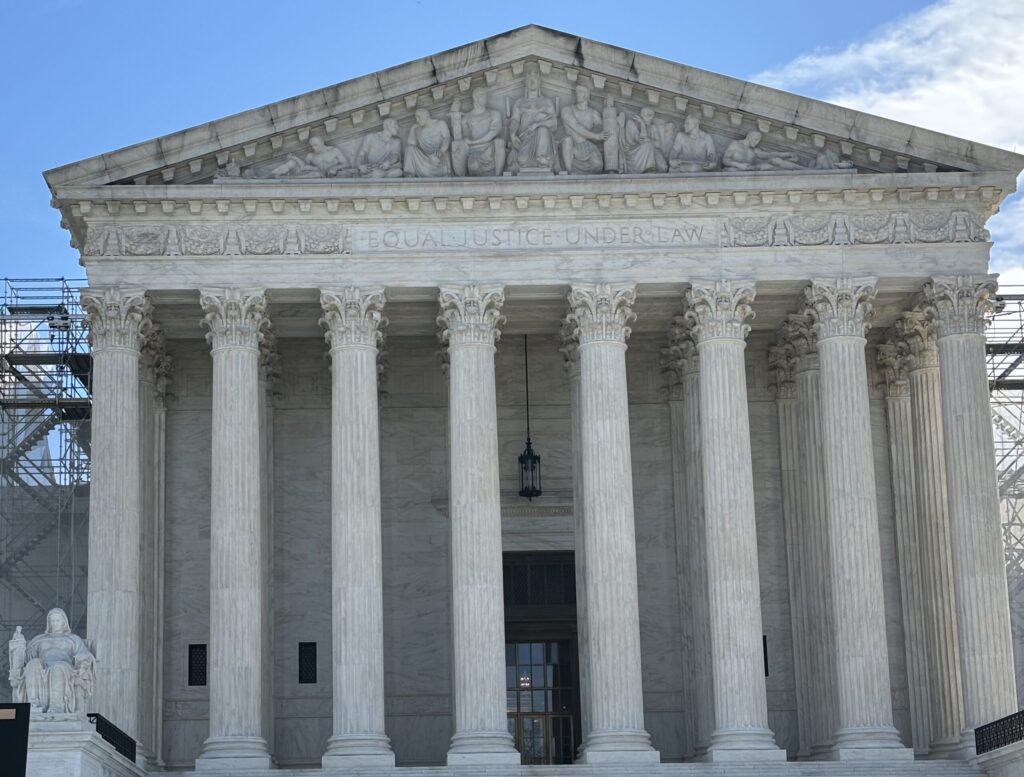
The U.S. Supreme Court announced Monday it would hear arguments in a lawsuit challenging Louisiana’s congressional redistricting plan that has two majority-Black districts, the latest development in a redistricting battle that has spanned nearly three years. (Jane Norman/States Newsroom)
The U.S. Supreme Court announced Monday it would hear arguments in a lawsuit challenging Louisiana’s congressional redistricting plan that has two majority-Black districts, the latest development in a redistricting battle that has spanned nearly three years.
The decision, which came in the case Callais v. Landry, which was brought by non-Black voters against Secretary of State Nancy Landry, will not impact this week’s election. The Supreme Court ruled earlier this year the state could use the challenged map despite a lower federal court ruling that the map is an unlawful racial gerrymander.
The fight over how to draw the state’s six congressional districts has involved multiple stops in lower courts and the U.S. Supreme Court. Louisiana legislators originally drew a map that maintained a single majority-Black district, despite one third of the state’s population being Black. That map was eventually overturned in the case Robinson v. Landry.
In response to that ruling, lawmakers redrew the map earlier this year which has two majority-Black districts. A panel of three federal judges — one appointed by former President Bill Clinton and two by former President Donald Trump — found the new lines for the 6th Congressional District were illegal. They ruled the lines had been drawn based on race, rejecting the state’s argument that the drawing of the lines was driven by politics. Partisan gerrymandering remains legal in the United States, but racial gerrymandering is not.
The case will turn on an argument from a set of strange bedfellows: conservative Attorney General Liz Murrill and Black voters, represented by the NAACP Legal Defense Fund. The NAACP fought Murrill and Jeff Landry in court over the 2022 redistricting plans.
“I think it’s very clear that this map was motivated by politics, which this court has not only welcomed, but also encouraged,” Jared Evans, an attorney with the NAACP Legal Defense Fund, said in an interview with the Illuminator.
Evans said he is confident the Supreme Court will uphold the map.
GET THE MORNING HEADLINES.
To comply with the ruling in Robinson v. Landry, the Republican supermajority Legislature had to choose a GOP congressional member to sacrifice, as a second majority-Black district would be more likely to elect a Democratic representative.
The obvious choice would have been Rep. Julia Letlow of Monroe, whose northeast Louisiana-based 5th District could be reconfigured into a compact majority-Black district. But legislators instead opted to redraw the 6th District, presently held by Rep. Garret Graves of Baton Rouge.
To do so, Republicans had to draw a map that complied with fewer traditional redistricting principles, creating district lines that run from Shreveport to Baton Rouge, slashing down the center of the state, veering to pick up small clusters of Black voters along the way.
Republican legislators said throughout the redistricting process they wanted to protect GOP incumbents House Speaker Mike Johnson, House Majority Leader Steve Scalise and Letlow, who sits on the powerful appropriations committee. The fifth member of Louisiana’s Republican delegation, U.S. Rep. Clay Higgins, R-Lafayette, is protected by geography because his district could not be significantly altered in the new map.
Notably left off that list was Graves, who ruffled some feathers with Republicans nationally and at home. He was widely viewed as insufficiently supportive of Scalise’s failed bid for House speaker.
Graves also endorsed Stephen Waguespack, one of Landry’s opponents in the 2023 gubernatorial election, potentially putting him crosswise with a powerful governor whose endorsement of the congressional redistricting plan was key in getting it across the finish line.
In a statement, Murrill said she was looking forward to defending the map, which she believes to be constitutional. Arguments in the case will likely be held early next year.
If the court overturns the map, the Legislature will likely get another shot at redrawing the map — a task likely to frustrate Republicans.
“We have said all along, in defending the old map and the new one, that the Supreme Court needs to provide more clear guidance to legislators and reduce judicial second-guessing after the Legislature does its job,” Murrill said.
The drawing of the map is also likely to frustrate state Sen. Cleo Fields, D-Baton Rouge, who is the favorite to win the newly-drawn 6th Congressional District. He previously held the majority-Black 4th District that was twice thrown out as an unconstitutional racial gerrymander.
Fields has not yet responded to a request for comment made with a campaign representative.
The court’s decision in Callais v. Landry will be of national significance, as the balance of power in Congress teeters on the edge. While Republicans are currently favored by a razor-thin margin to maintain control of the House in this week’s election, a single district flipped one way or the other could make all the difference in the 2026 election.
YOU MAKE OUR WORK POSSIBLE.

